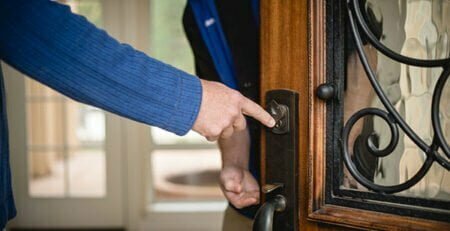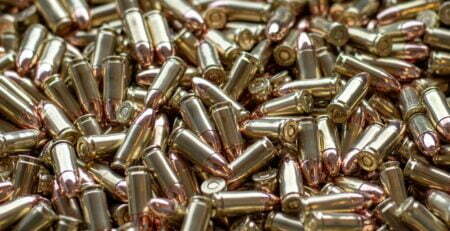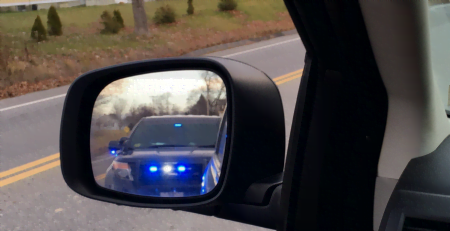
DEBUNKED: 30 Gun Myths You May Still Believe
Click-Click-Boom2021-09-14T01:37:52-05:00You can shoot a guy on your property, especially if he is across your doorway.
You can shoot anyone who is threatening your life with a deadly weapon or who has the ability to kill you using any means. You cannot shoot anyone — on your property or off of it, in your home or on your patio, or half-inside and half-outside your house — unless he or she has the ability to grievously injure or kill you. A burglar carrying your TV away from your house doesn’t put you at risk of death. Don’t shoot.
Pointing a gun at them or, better yet, racking a round into your shotgun will stop most bad guys.
While the shotgun-rack move sounds great on TV and in the movies, there’s no real evidence it deters anyone who wants to murder you. You should point your gun only at what you plan to shoot. Keep your gun in a safe or holster, pointed safely toward the ground at your side (and at an angle away from your foot) or in the low-ready position until you need to fire it. We don’t point guns at people to scare them or for show.
Glocks rarely need cleaning or lubrication.
Despite Glock’s awesome marketing efforts — showing pistols covered in water, mud and who-knows-what else — all machines with metal moving parts need to be cleaned and lubed. Read the Glock instruction manual that came with your gun (or download it online) or watch YouTube videos for the best ways to clean and oil your Glock pistol.
You don’t need to aim a shotgun; just point it in the general direction of the bad guy and pull the trigger
You had better never say that to the police, a prosecutor or a civil attorney. We aim every firearm and take great care in where rounds go when they leave whatever-sized barrel. We use our training and experience when operating a shotgun; we don’t just “spray and pray.”
You don't need a holster for a pocket gun.
Sure … if you want to make that gun more likely to get stuck in your jacket or pants pocket or fall out in public in an embarrassing way, or if you want to shoot yourself as you grab for a gun with an uncovered trigger.
Don't leave rounds in your magazines too long; you'll wear out the springs.
The opposite is more likely. Taking your rounds in and out of your magazine too often — not at the range, but just to have something to do — is what can wear out the springs. If you buy factory mags and not cheap knockoffs, you shouldn’t have issues with worn springs.
You don't always need a holster; just jam your gun under your belt.
Same as with a pocket gun, if you move in public without a holster, you risk injuring yourself, negligently discharging your gun, dropping your gun or maybe even getting disarmed by a bad guy who sees you don’t know how to properly carry a sidearm.
You don't need to carry extra rounds.
Even cops, who are supposed to be well-trained, fire and miss in gun battles. One round won’t stop most bad guys right away, even if it’s sent into an attacker’s head or heart. There are few worse sounds in the world than your revolver’s hammer falling on an empty chamber or your pistol cycling back to reveal an empty mag. Guns fail
and magazines fail. It’s better to have a backup for each handy and nearby.
You don't need an Everyday Carry (EDC) or ``Get-Home`` bag.
Yes, you do. Consider your EDC bag to be a lifeline when things go south. Opinions vary as to what essentials you’ll need, but consider packing a flashlight, batteries, a knife, a compass, a glow stick, extra rounds in magazines or speedloaders, a tourniquet, a pressure bandage, extra cash, a credit card, a phone charger, granola bars, bottled water, a foil emergency blanket, a butane lighter and some paracord.
Bugout bags are for doomsdayers, preppers and worriers.
Maybe before 9/11 you could make this argument, but certainly not now. Consider the value of having a bugout bag in your car, at your office or worksite, and certainly in your home. Fill it with the contents of your EDC bag above, except times 10 and on steroids. You’ll need enough water, food, cash, toilet paper, toiletries, guns and ammunition, knives, and heat and shelter resources to keep you and/or your family safe and protected for at least a week. It’s not only bad guys storming your walls but also weather incidents and wildfires that can put you on the run. Stop putting this on your “I’ll get around to it” list and make it happen now.
You won't need an individual first-aid kit (IFAK) at the range or anywhere else; rely on the paramedics.
This might be true if you live in a town where your fire department and ambulance companies are fully funded and fully staffed, but millions of Americans live in areas where this is not the case and where response times can range from concerning to excessive. As such, while we love our first responders, it’s up to you to be ready to provide first aid to yourself or others within the so-called critical “Golden Hour.” Take a first-aid class, which should include tourniquet training, CPR and AED training, and basic bloodstopping and bandaging. The leg you save at the range or in the streets could be your own, a family member’s or a stranger’s. First aid is a necessary skill for all who live the concealed carry lifestyle.
You don't need a flashlight in the daytime.
Some daywatch cops have said this, only to answer calls involving unlit warehouses, attics with home invaders inside or other dark areas where using the flashlight option on their iPhones just wouldn’t cut it. Get into the habit of having a flashlight on your belt, in your pocket or in your EDC bag so you won’t have to look for it whenever the sun goes down.
The police and the district attorney will be on your side if you're foced to shoot someone in self-defense.
Maybe they will, and maybe they won’t. They may think you’re a good person who did a good thing with your gun; they may think you’re a good person who did the wrong thing with your gun; or they may think you’re something far worse than that. Either way, they’re going to analyze your motives, actions and decisions in ways you didn’t think possible. Prosecutors and DAs say they are “on the side of the law and the search for and application of equal justice,” but we know that’s not always true. As your criminal defense lawyer should have already told you, the cops are not always your friends. Until your lawyer gets there, keep your statements to a minimum: “I feared he was going to kill me, so I defended myself. I’ll wait to speak to my attorney before I answer any other questions.”
It's OK if people see the imprint of your gun under your clothing or a bit of your holster under your coat.
Since we already know we live in a country where roughly half the people hate people who own guns and about half the people love, like or don’t mind people who own guns, be careful to not allow your firearm to draw attention to you in any public place. The goal when you leave your residence is to never show your holster, any part of your gun or even any imprint of your holster, mags or gun. Dress accordingly, and keep covered what needs to be covered.
A bad guy won't try to disarm you if you're holding your gun on him or if he sees your gun in your holster.
Admittedly, this last part is a rare possibility, but we’ve seen it happen, especially in crowded, confined spaces, where a slick-fingered crook sees someone carrying a gun and basically pickpockets it as he goes jostling by. In the disarming scenario, really violent predators, who have spent time in jails and prisons, actually practice gun takeaways with each other. Regardless of whether a bad guy wants to take this risk with you as you’re defending yourself or with a cop who tries to arrest him at gunpoint, know that he may be quite skilled at such maneuvers. Always keep your gun holstered and covered until you need to draw it, and never get close enough that you can be disarmed by a criminal at whom you are pointing your gun.
You can carry your semi-automatic pistol with an empty chamber because you'll have time to load it when you need it.
If, under life-threatening stress, you have the ability and motor skills to first remember to draw your gun and then jack a round into the chamber just prior to firing, you’re a whiz kid. Most people don’t have that kind of pre-trained sense, so the next sound they hear in a real gunfight is a horrible click as the striker-fired hammer
falls upon emptiness. Some cops back in the day kept their duty guns — whether revolvers (see below) or pistols — in this highly unsafe position. With this highly unsafe approach, you add additional and unnecessary steps into a stress-filled environment. Who knows if you can remember to do this? And why should you have to?
7 18 16 Setting up your revolver so the hammer falls on an empty chamber is a good way to prevent accidental discharges or to keep from getting shot with your own gun if you get disarmed.
See above. There just isn’t any good reason to do this with a modern revolver.
You can keep your finger inside the trigger guard even if you’re not ready to fire.
No. Run a Google or YouTube search for “accidental discharges” and see how many times someone had his or her finger on the trigger just seconds prior to negligently sending a round into the ground, someone’s body, or his or her own hand, arm, foot or leg. Cops tend to do it a lot, even though they have supposedly been trained not to put their fingers inside their trigger areas when they are running after a suspect, searching a room or arresting someone. It’s a horrible and potentially deadly habit. Just because you see TV and movie cops doing it doesn’t mean you should.
You won't be able to put on your own tourniquet if you get shot.
First, yes you can. Second, you had better be able to. Plenty of people in combat situations have saved their own lives with tourniquets, provided they’ve had the proper training and time to apply them. Tightening a tourniquet on a wounded extremity and packing your own wounds are lifesaving skills you need to have banked if you are going to carry a gun.
If a law enforcement officer is in danger, he or she will want you to help him or her with your gun.
Maybe and maybe not; there are no hard-and-fast rules on when to help an officer struggling with an armed, mentally ill or intoxicated suspect and when to simply be a good witness and wait for more officers to arrive. We’ve all seen stories on the internet in which law-abiding citizens with concealed carry permits intervened and saved the lives of cops who were in grave danger. They’re both phenomenal and rare. It’s better to be asked to help, when you can first quickly and safely tell the cop without distracting him or her that you’re armed and can provide assistance. In a situation where it’s obvious the cop is about to be murdered or disabled and will thereby welcome the help, you may have to act differently. Otherwise, stand by and don’t add to the officer’s problems.
You should tell your friends and neighbors that you carry in case you need to protect them.
It’s best to keep that info to yourself in order to avoid lengthy arguments with antigun types or to keep your house and guns from being ripped off by your friends’ creepy acquaintances. Some types keep their ears open for opportunities to steal from people they know or who are known to mutual friends because it’s just easier.
It’s OK to leave your gun in the glove box or center console while you’re driving or when you leave the car.
Two problems here: It can be hard to quickly get your gun out and on target from a seated position, even when it’s in a holster on your ankle, under your shoulder or on your waistband. If you leave your gun in your glove box or center console, there is a good chance it won’t be there when you get back to your car a few hours (or even a few minutes) later. Carrying concealed means we carry.
Big bullets sent from a big gun will protect you better than smaller bullets sent from a smaller gun.
Shots that miss the predator they were aimed at are worthless, regardless of caliber. You should be able to reliably land hits with whatever sidearm or cartridge you’re carrying. If that means you have to get really good with one particular gun and cartridge first, before you start switching models and sizes, so be it.
It’s OK to carry concealed if you’ve had a few drinks, as long as you don’t drive
If you end up forced to defend yourself, chances are good the cops will test some fluid from your body for drugs and alcohol. In fact, your criminal defense attorney may insist that they do to forensically prove that you were clean and sober and that no alcohol or drugs, legal or illegal, were in your system at the time you were forced to pull the trigger. This will prevent a prosecutor or civil attorney from putting you on the stand and asking, “So on the night in question, you really don’t know how drunk you actually were, do you?” or “How many prescription pills would you say you need to take to be impaired or don’t you know?” The only way to make sure there are no drugs or alcohol in your system at the time of an incident is to make sure there are no drugs or alcohol in your system if you have to fire your gun. In other words, it’s an easy decision: Plan on having a few drinks tonight? Don’t carry and don’t drive.
Dry-firing can damage your gun.
Always check your owner’s manual, but unless the manufacturer of your particular handgun advises you not to dry-fire your gun, it can save your life. Perfect practice makes perfect shooting, so be safe when doing it, and do it a lot.
You don’t need to practice at the range or dry-fire once you get your concealed carry permit.
No and no. Getting your concealed carry permit means the real range work, classroom training and attendance at instructor-led courses has just begun. Train, train some more and remember that the loaded gun will only be able to do so much for you if you don’t remain competent in its use.
If your attacker takes a knee, you can no longer shoot him.
This angle of the use-of-force situation is always difficult. Some attackers will go down and stay down after being shot once, while others remain engaged in the fight literally until they stop breathing. You can’t shoot an attacker who gives up from his knees, but there’s a reason people down south call it “playin’ ’possum.” Be fully aware of when the threat to your life is truly over.
It’s a waste of time to practice shooting with just your support hand.
Since you very likely shoot with your strong-side hand on your gun and your support-side hand helping with the push-pull balance, positioning and grip, you’ll note that your hands and arms are often held around chest level. This means any attacker who shoots at your center-mass can easily hit one or both of your hands or arms. This means you need to know not only how to shoot one-handed but also how to load your revolver or pistol with just one hand.
As long as you have a concealed carry permit, it’s better to shoot an attacker than to escape or get behind cover.
Back to those tough questions by prosecutors and civil attorneys who want to nail your hide to the courtroom wall. Your first choice of self-defense needs to be to avoid the fight. Every other option will only happen, legally and ethically, after that choice has evaporated. If you have the chance to protect yourself from behind solid cover without firing and can be a good and rational witness until the police arrive, do that. Protect yourself with deadly force only as a last resort, and be able to fully explain why that was your only choice.
If you have your concealed carry permit, you can clear your house by yourself if someone breaks in.
Maybe, if you live in a rural community where law enforcement is a substantial distance away and your family is inside. Otherwise, if your house is empty, take up the best observation position near the house, make sure you can see the perimeter, and let the pros arrive and do their thing. They have radios, vests, long guns, tactical training and experience doing this sort of dangerous work.




